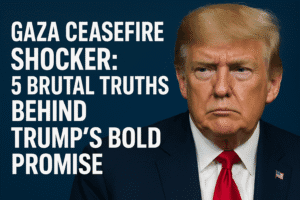Gaza Ceasefire Shocker: 5 Brutal Truths Behind Trump’s Bold Promise
President Trump declared a Gaza ceasefire possible “within the next week,” citing U.S. efforts driven by the catastrophic humanitarian crisis. However, this optimism clashes sharply with the collapse of a previous U.S.-brokered truce in March 2025 and Israel’s subsequent devastating offensive and two-month total aid blockade, which pushed Gaza toward famine. While limited aid now flows via a controversial U.S.-funded mechanism involving security contractors, this very system has been marred by deadly incidents against desperate Palestinians.
Disturbing reports allege Israeli forces fired on unthreatening aid crowds, though denied by Netanyahu. The jarring juxtaposition of new U.S. funding for this problematic aid conduit alongside ceasefire talks highlights the complexity. Achieving any truce requires overcoming a profound deficit of trust between Israel and Hamas after past failures, with no clear path addressing core conflict issues. A temporary halt in fighting, while urgently needed for suffering civilians, offers no solution to the underlying crisis.

President Donald Trump’s declaration on June 27th, 2025, that a Gaza ceasefire could materialize “within the next week” injected a sudden jolt of optimism into a conflict marked by relentless suffering. Yet, beneath this headline-grabbing prediction lies a complex tapestry of geopolitical maneuvering, deep-seated distrust, and an escalating humanitarian catastrophe that demands a closer look.
The Spark of Optimism: Standing alongside Secretary of State Marco Rubio and Vice President J.D. Vance after meeting with Congolese and Rwandan officials, Trump pointedly addressed the Gaza crisis. “We think within the next week, we’re going to get a ceasefire,” he stated, framing U.S. involvement as a response to desperate human suffering: “We’re involved because people are dying… look at those crowds of people that have no food, no anything.” This assertion, while lacking specific details on the parties involved or the proposed terms, signals a potential intensification of U.S. diplomatic efforts.
The Shadow of Past Failures: Trump’s optimism starkly contrasts with recent history. A U.S.-brokered ceasefire, initially forged during the Biden administration with Trump team support, collapsed dramatically in March 2025. Israel resumed devastating attacks on Hamas, citing the group’s continued threat following the October 7th, 2023 attacks. Crucially, Israel also imposed a complete blockade on Gaza for over two months, a move widely condemned by humanitarian organizations and UN agencies warning of imminent famine. This context casts a long shadow over any new agreement, underscoring the fragility of past deals and the profound lack of trust between the warring parties.
The Humanitarian Abyss Deepens: While limited aid flows have resumed, primarily through the controversial “Gaza Humanitarian Foundation,” the situation remains catastrophic. This mechanism, involving U.S. security contractors and Israeli troop oversight, has been marred by violence. Multiple reports from witnesses and Gaza officials detail Palestinians killed while desperately waiting for essential supplies. Disturbing allegations surfaced in Haaretz, quoting unnamed Israeli soldiers claiming commanders ordered troops to fire on crowds near aid centers simply to disperse them, even without perceived threats – allegations Prime Minister Benjamin Netanyahu firmly denies.
Adding a new layer, the U.S. announced just one day before Trump’s comments a $30 million funding injection into this same controversial aid initiative. This creates a jarring juxtaposition: providing aid through a mechanism accused of enabling violence while simultaneously pushing for a cessation of hostilities. It raises critical questions about the coherence of the U.S. approach and the effectiveness of the chosen aid conduit.
The Skepticism Gap: Trump’s prediction faces significant hurdles beyond the immediate humanitarian crisis:
- Trust Deficit: The collapse of the previous ceasefire severely eroded trust between Israel and Hamas. What guarantees exist now that weren’t present before? How will compliance be verified?
- Defining “Ceasefire”: Is this envisioned as a temporary humanitarian pause, a longer-term truce, or a step towards a more permanent solution? The lack of detail fuels skepticism.
- Hamas & Israeli Stances: Public pronouncements from Hamas leadership or the Israeli government confirming active negotiations or willingness to accept a deal within a week are notably absent. Netanyahu’s government faces pressure from hardliners opposing concessions.
- The Aid Conundrum: Can meaningful diplomacy progress while civilians continue to die attempting to access basic necessities delivered through a problematic system?
Beyond the One-Week Horizon: Even if a temporary halt in fighting is achieved, Trump’s statement offers no vision for addressing the root causes of the conflict or the path towards lasting peace. The fundamental issues – Palestinian self-determination, Israeli security, the status of Jerusalem, borders, and refugees – remain untouched. A short-term ceasefire, while desperately needed to alleviate suffering, does not equate to a resolution.
Conclusion: A Fragile Hope Amidst Enduring Crisis President Trump’s prediction of a Gaza ceasefire within a week offers a glimmer of hope in a landscape defined by profound despair. However, this optimism is tempered by the harsh realities of a shattered trust, an ongoing humanitarian disaster where aid delivery itself is fraught with danger, and the absence of a clear path towards sustainable peace. The coming days will be a crucial test of U.S. diplomacy’s ability to bridge seemingly unbridgeable divides.
The world watches, hoping for relief for Gaza’s civilians, but mindful that true peace requires far more than a temporary silence of the guns. The hard work of building trust and addressing core grievances remains the indispensable, yet distant, goal.
You must be logged in to post a comment.